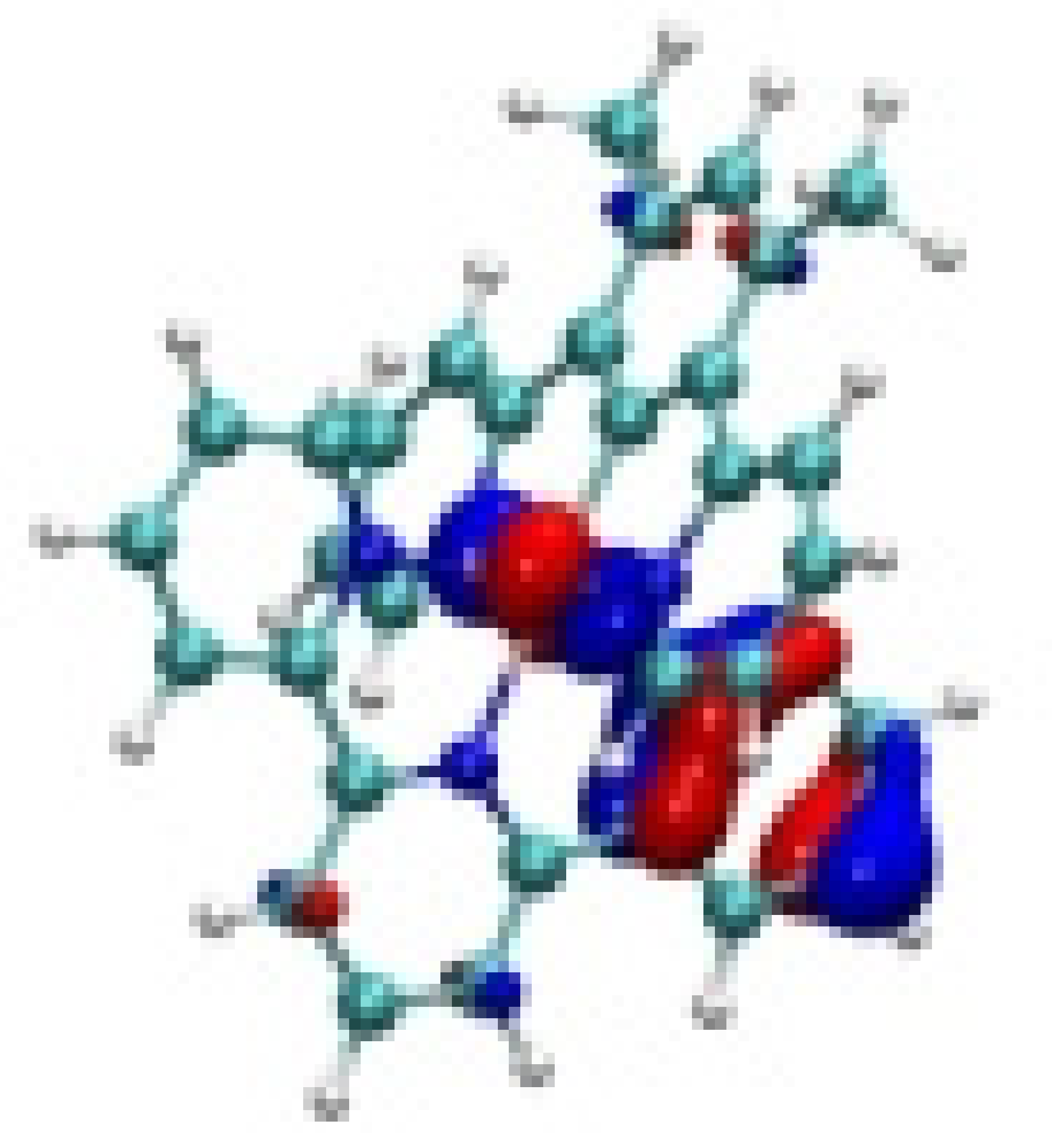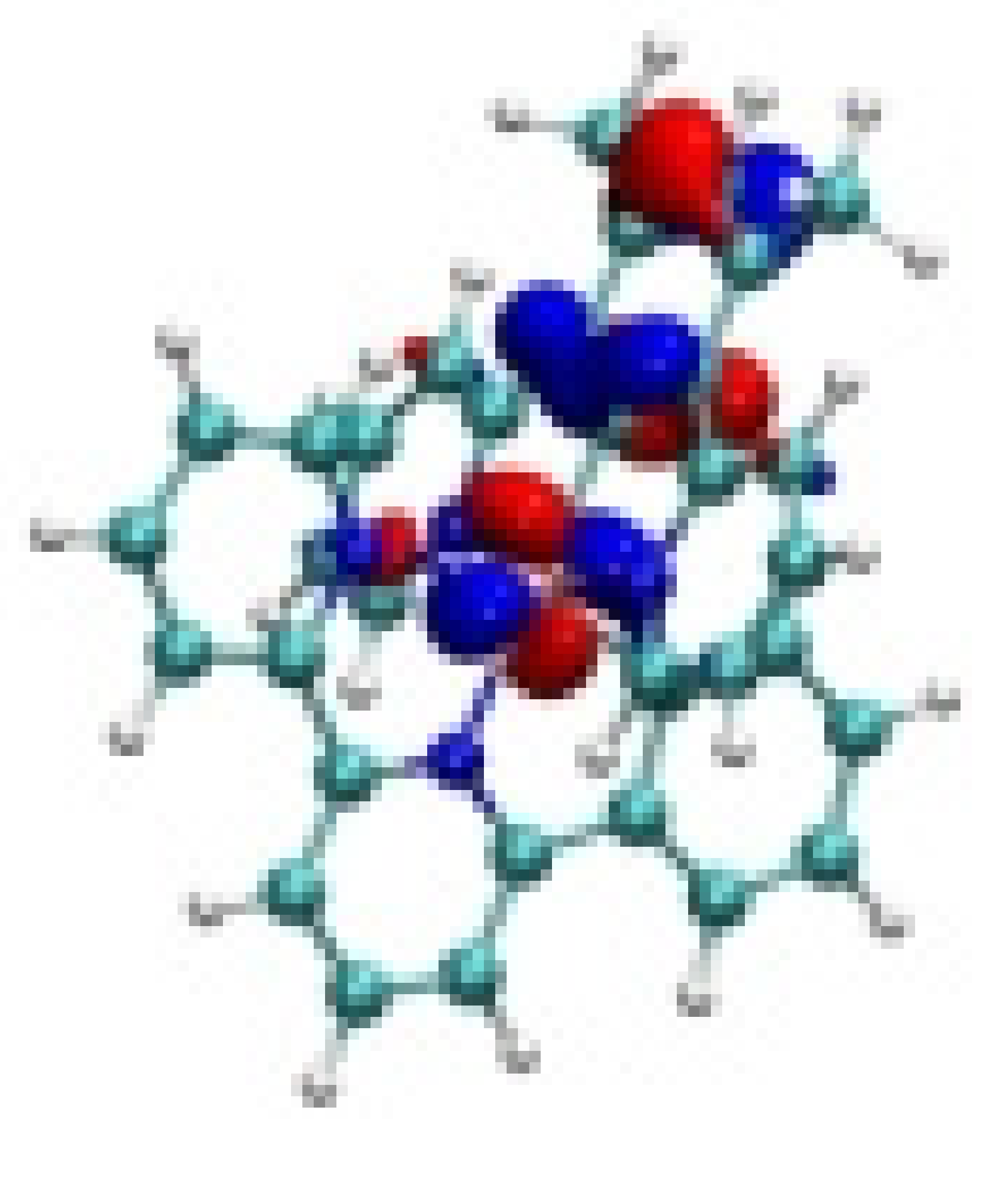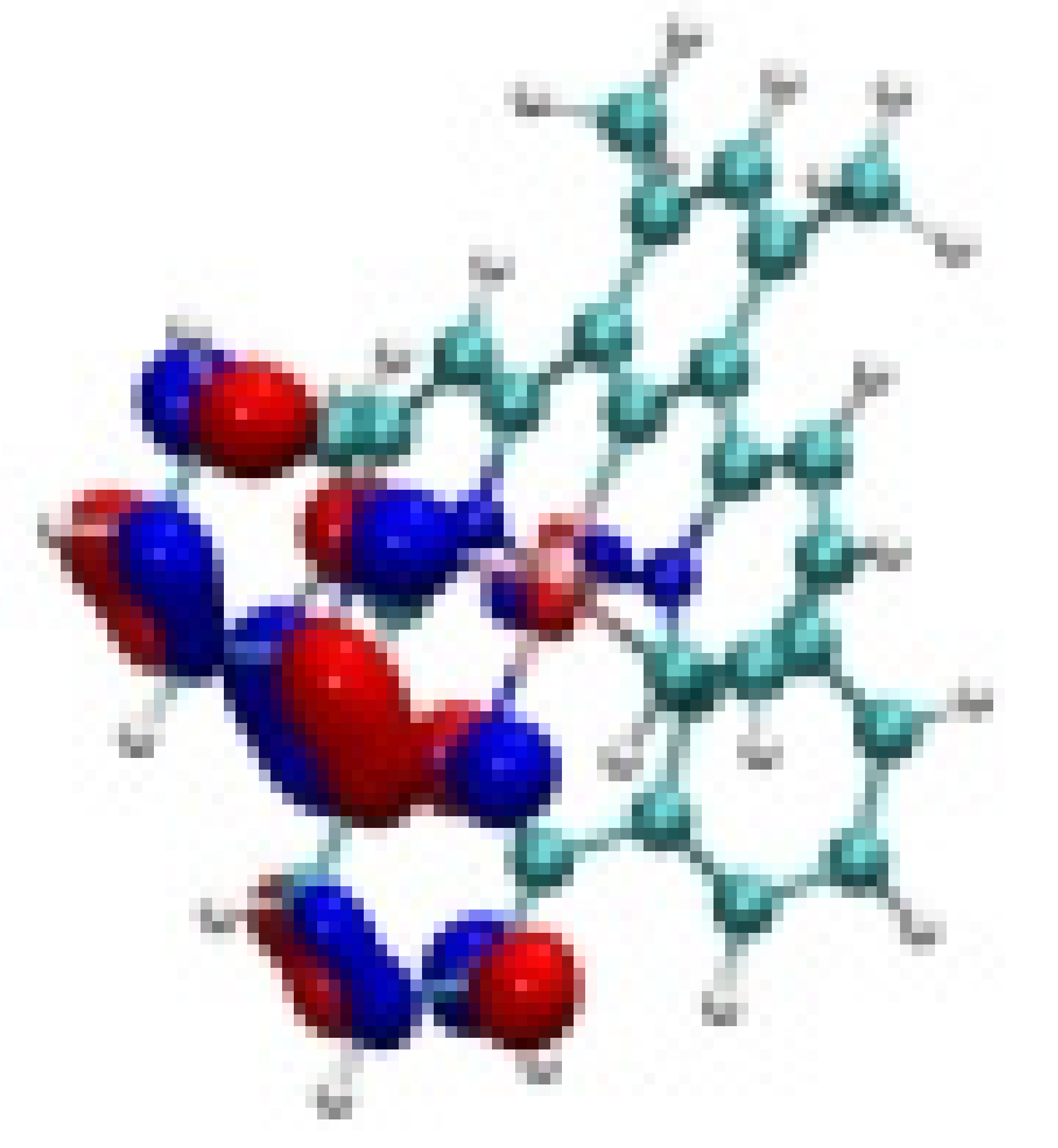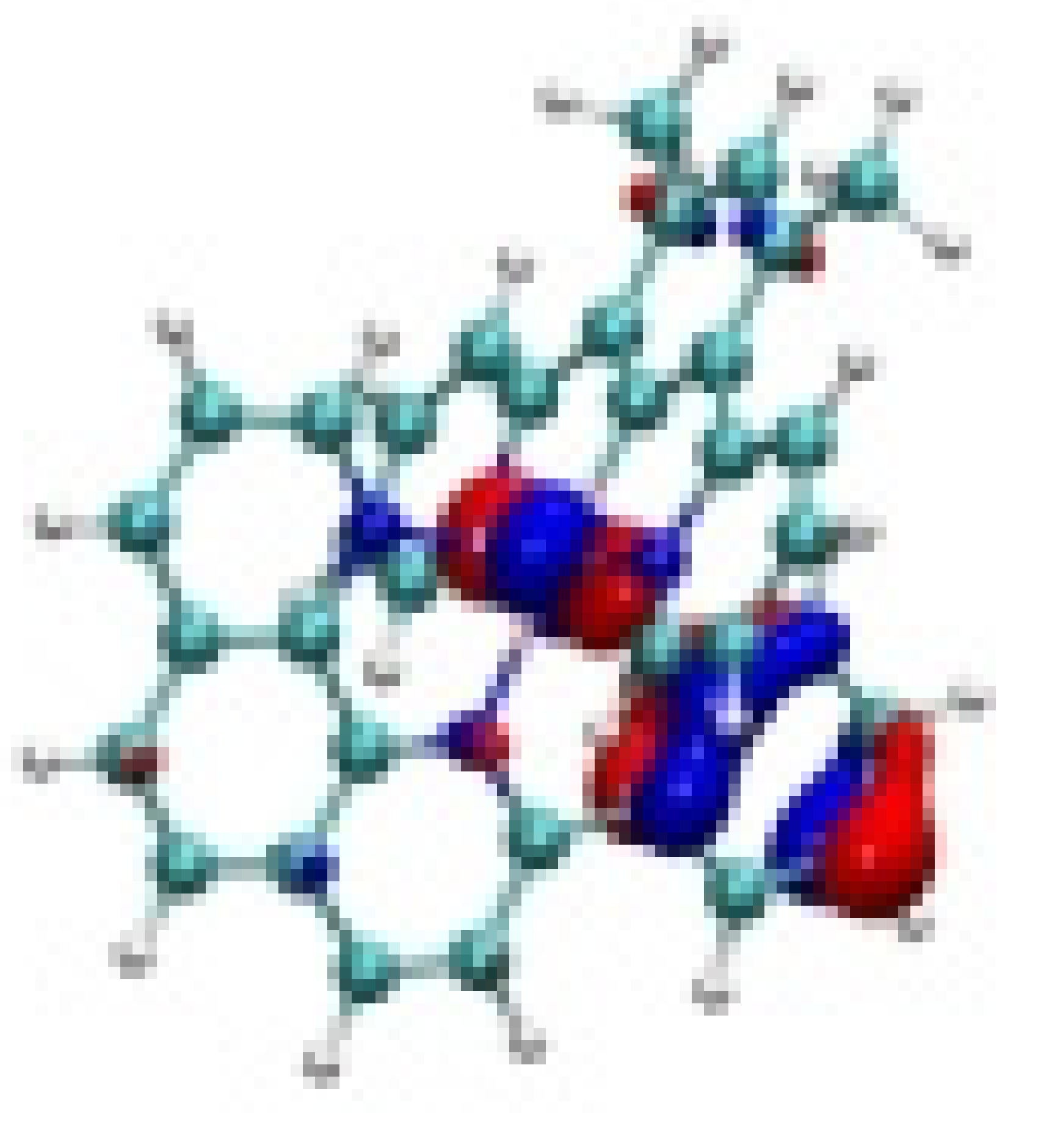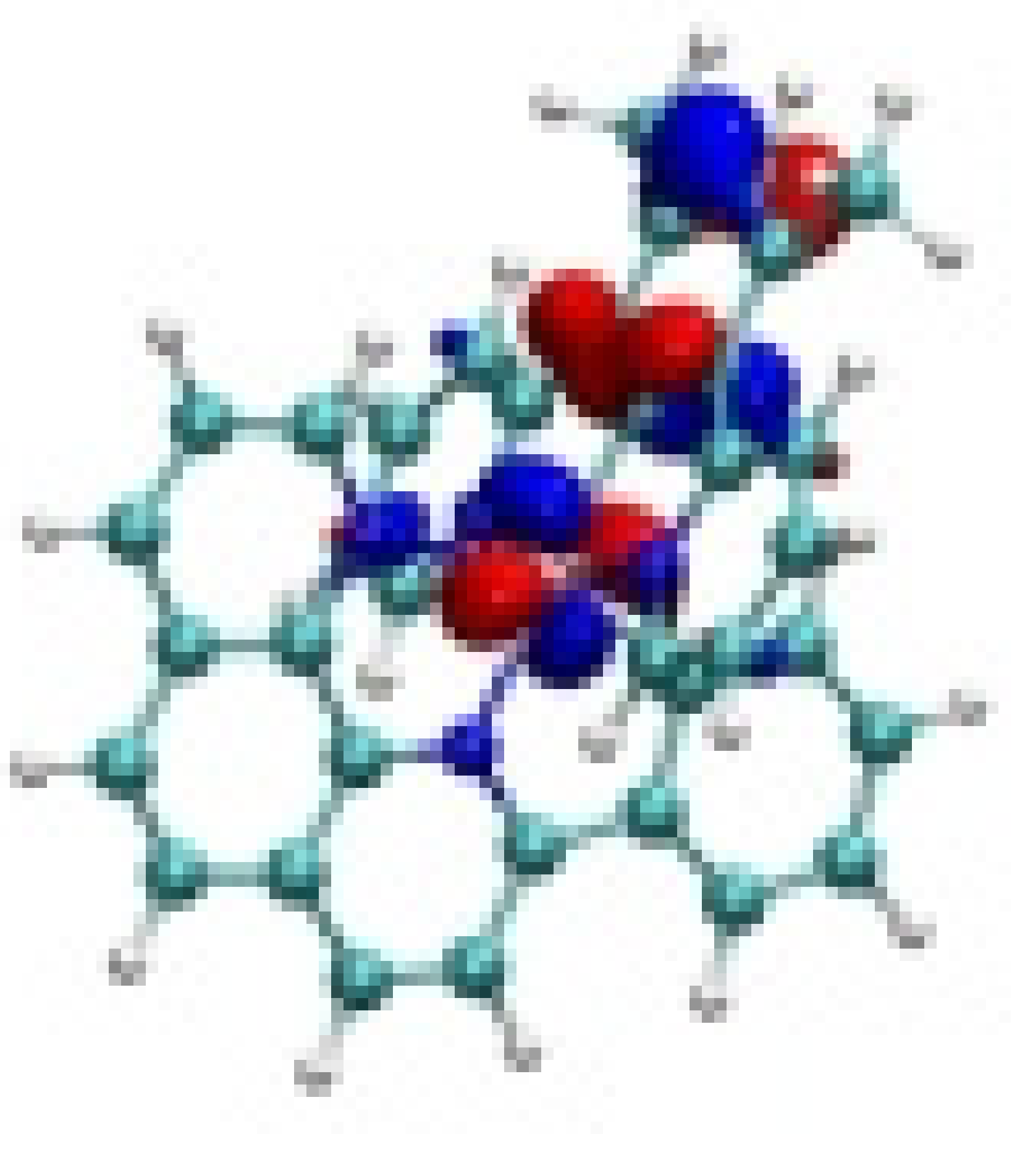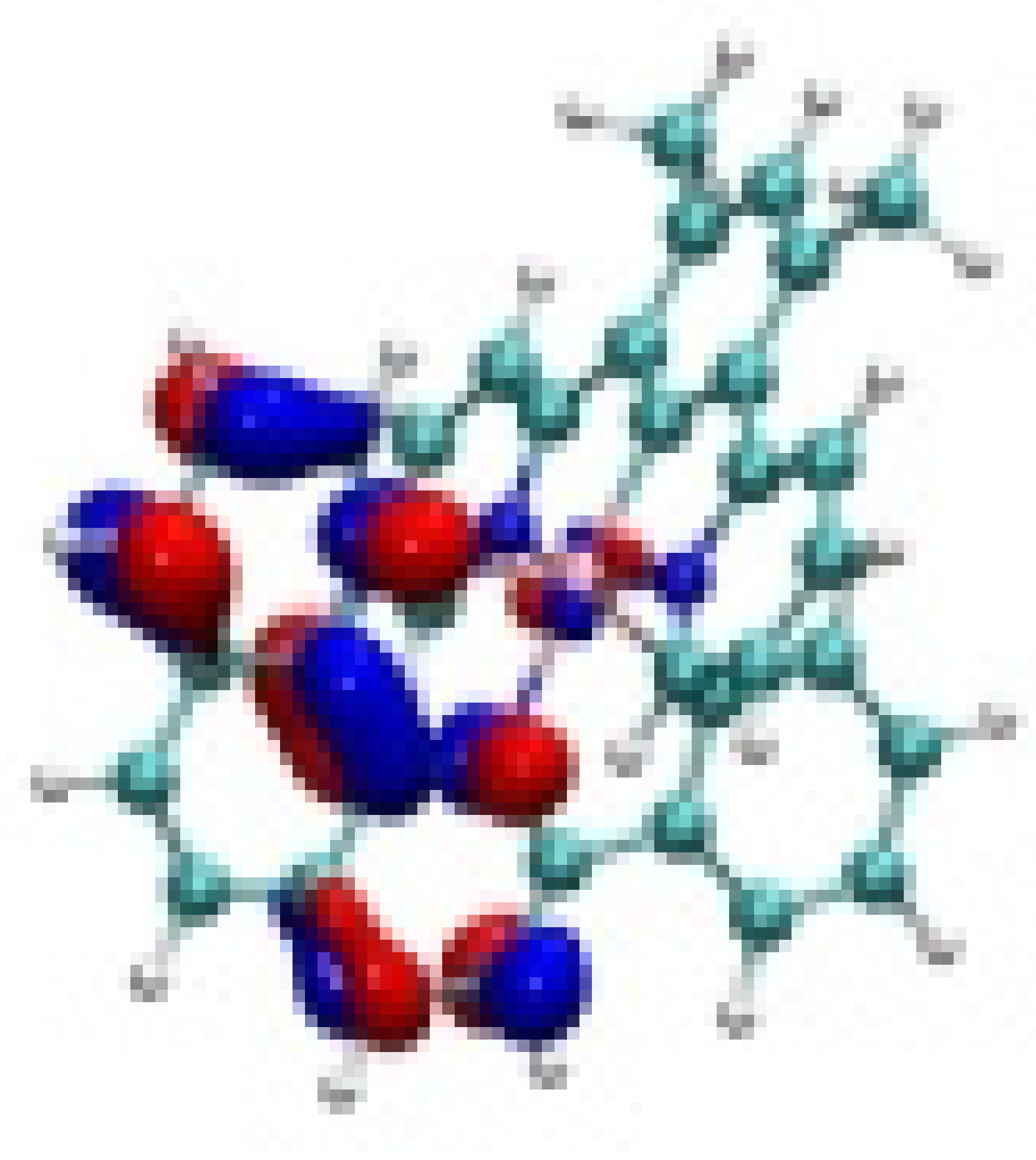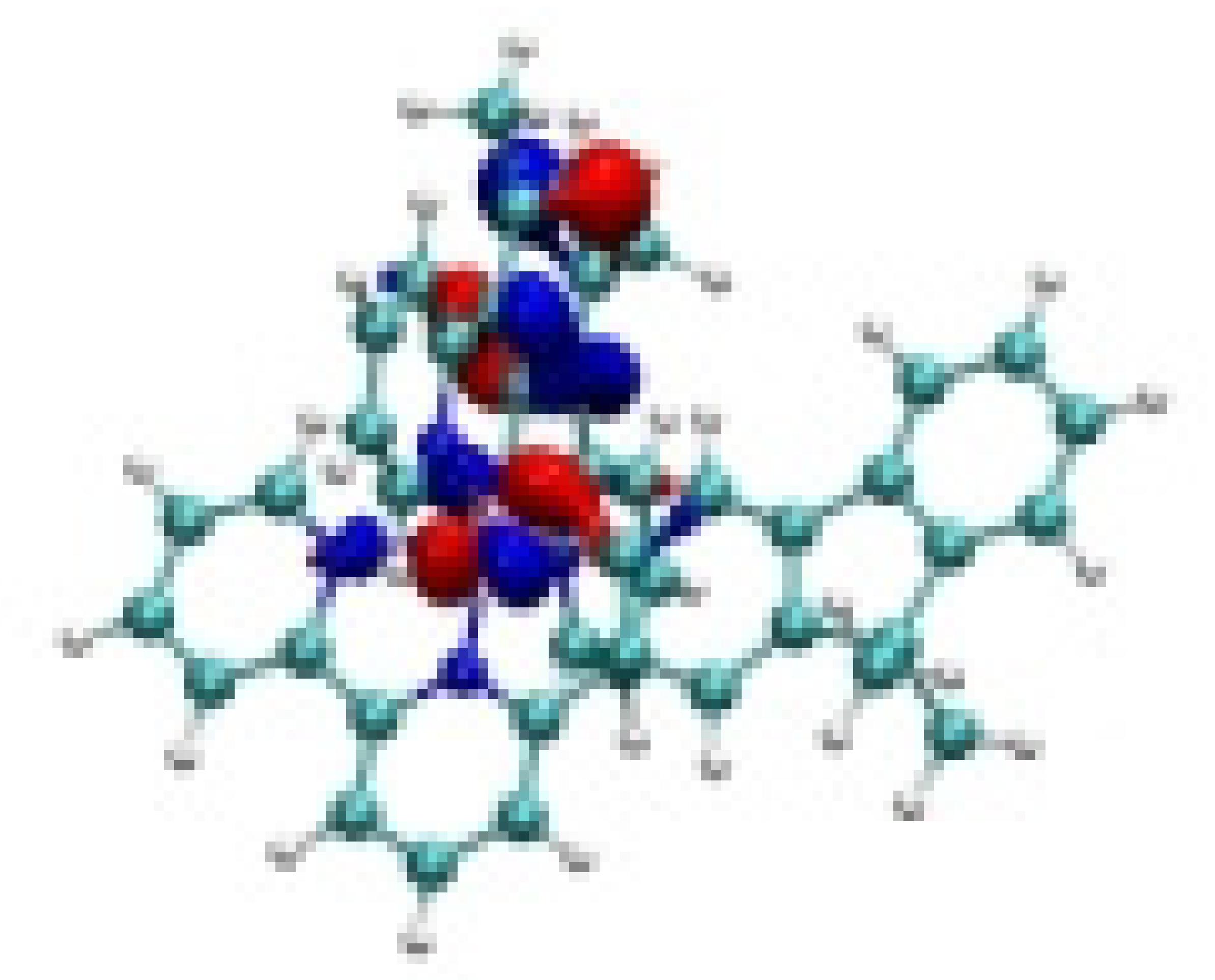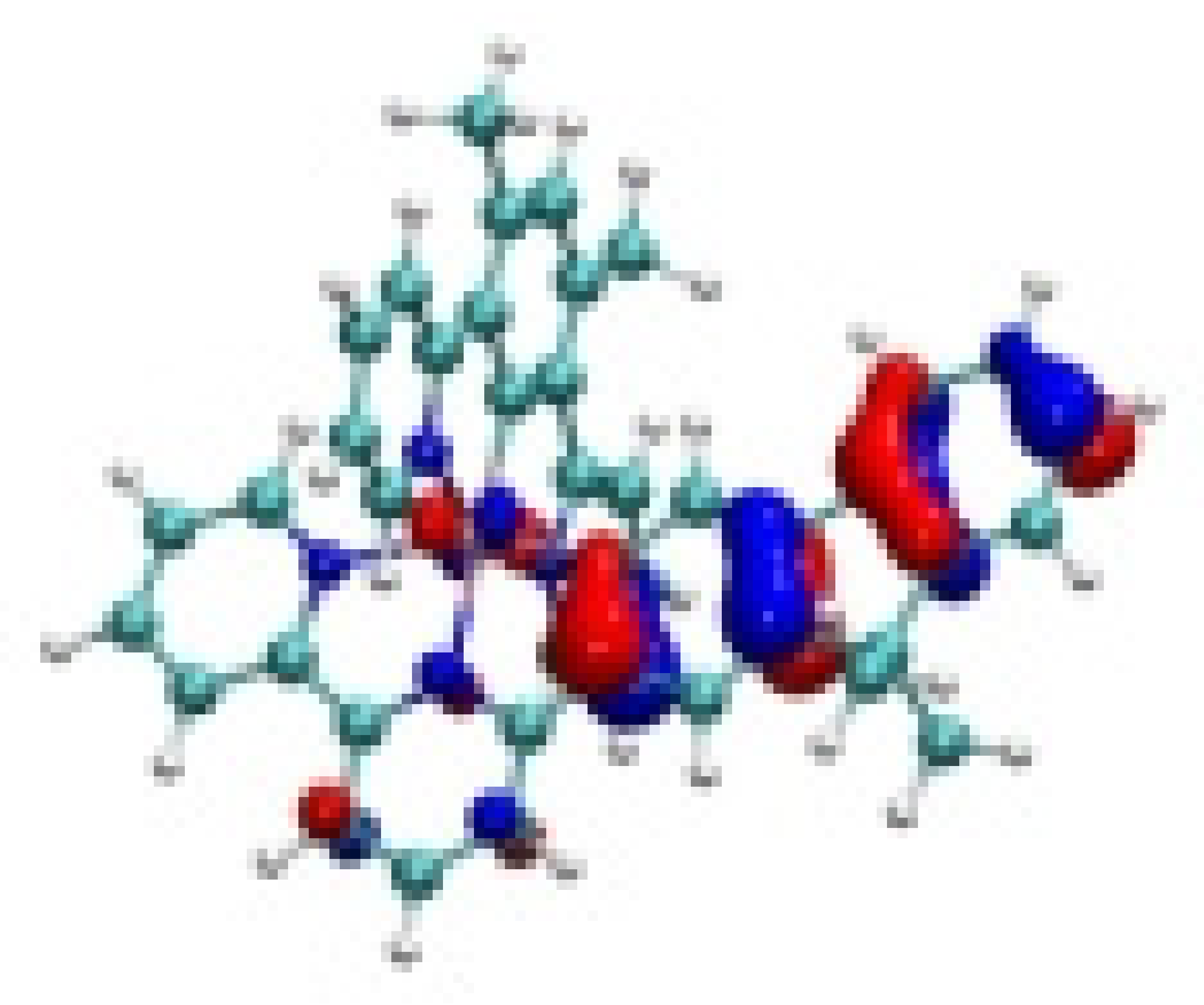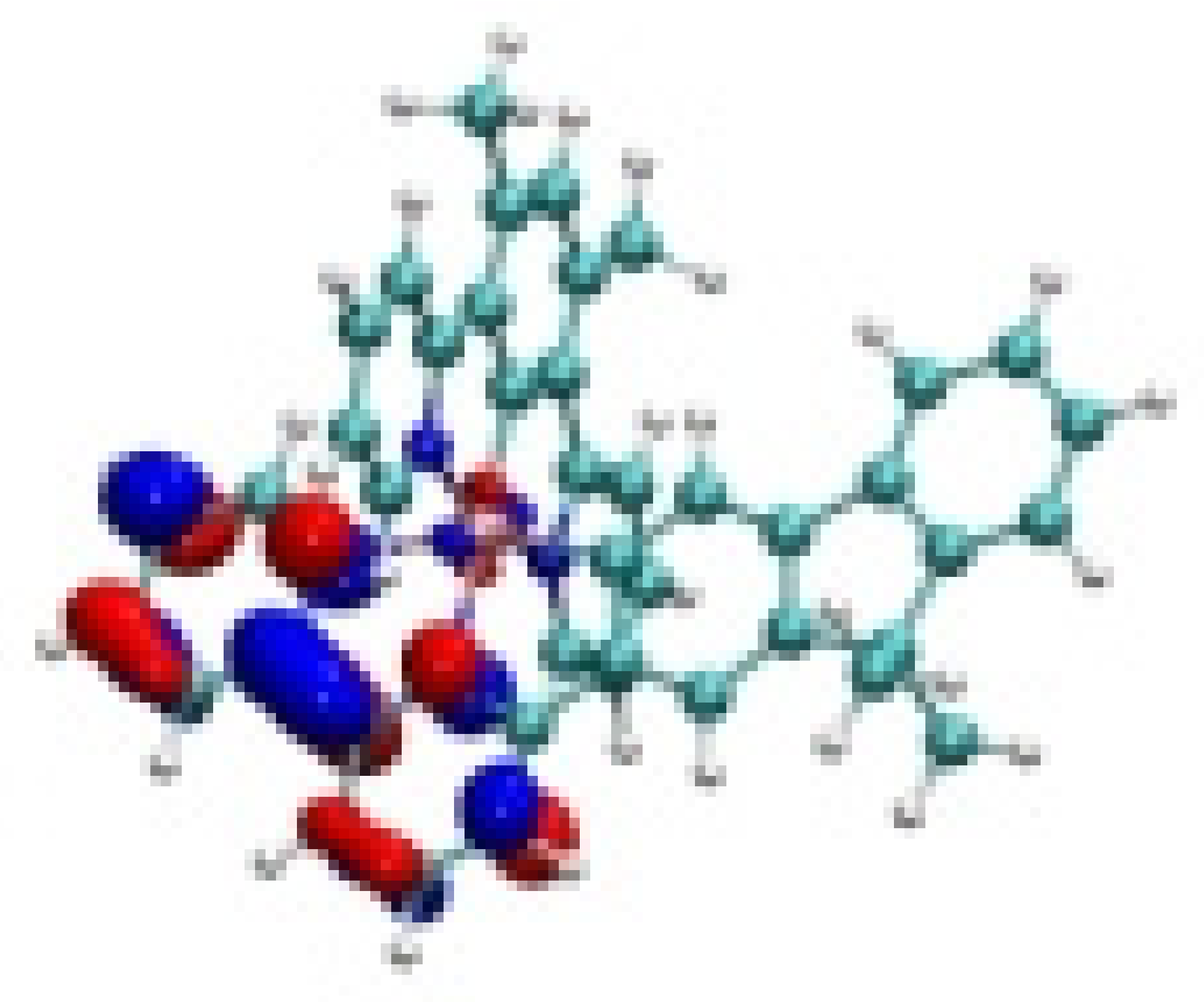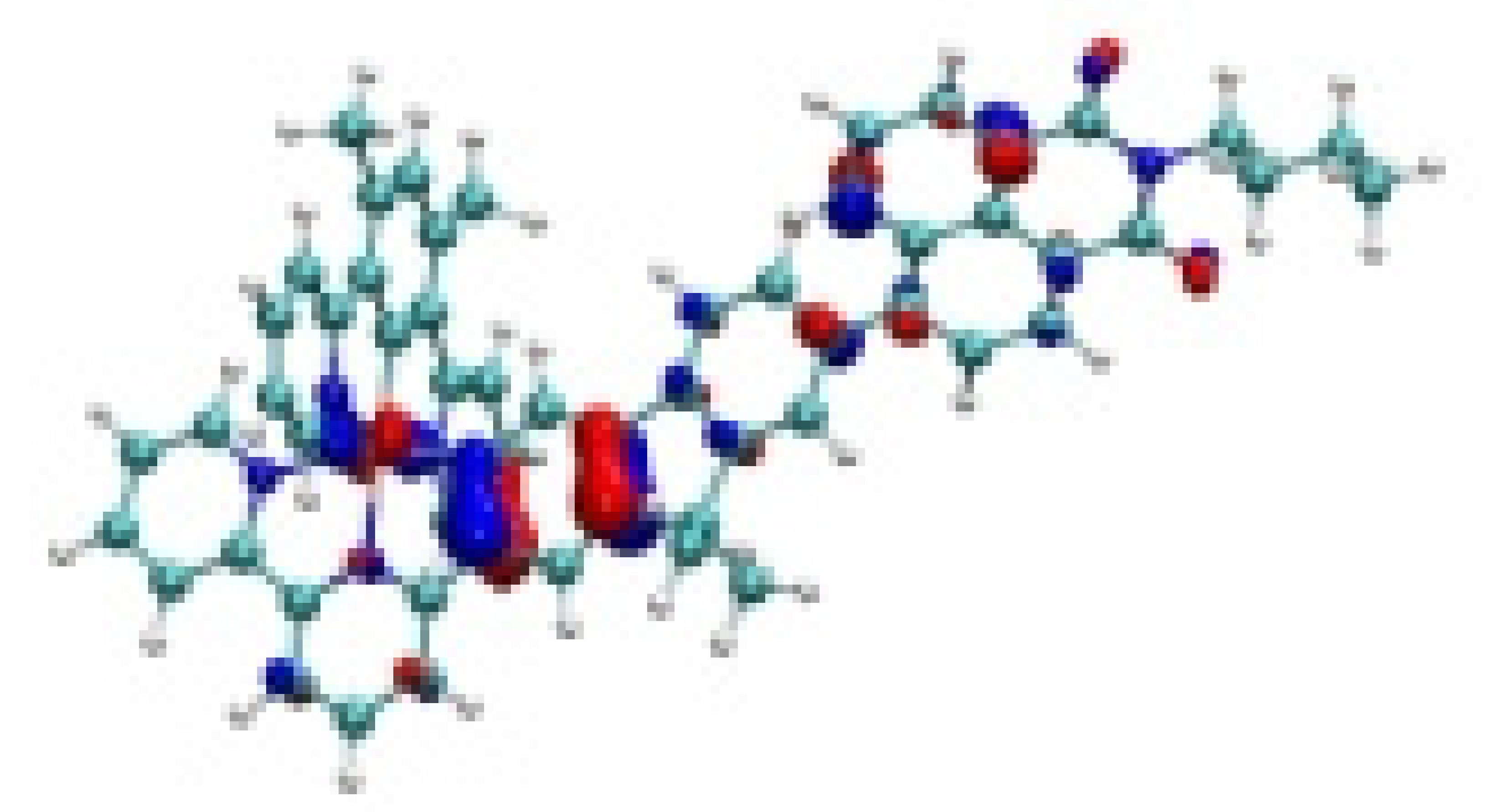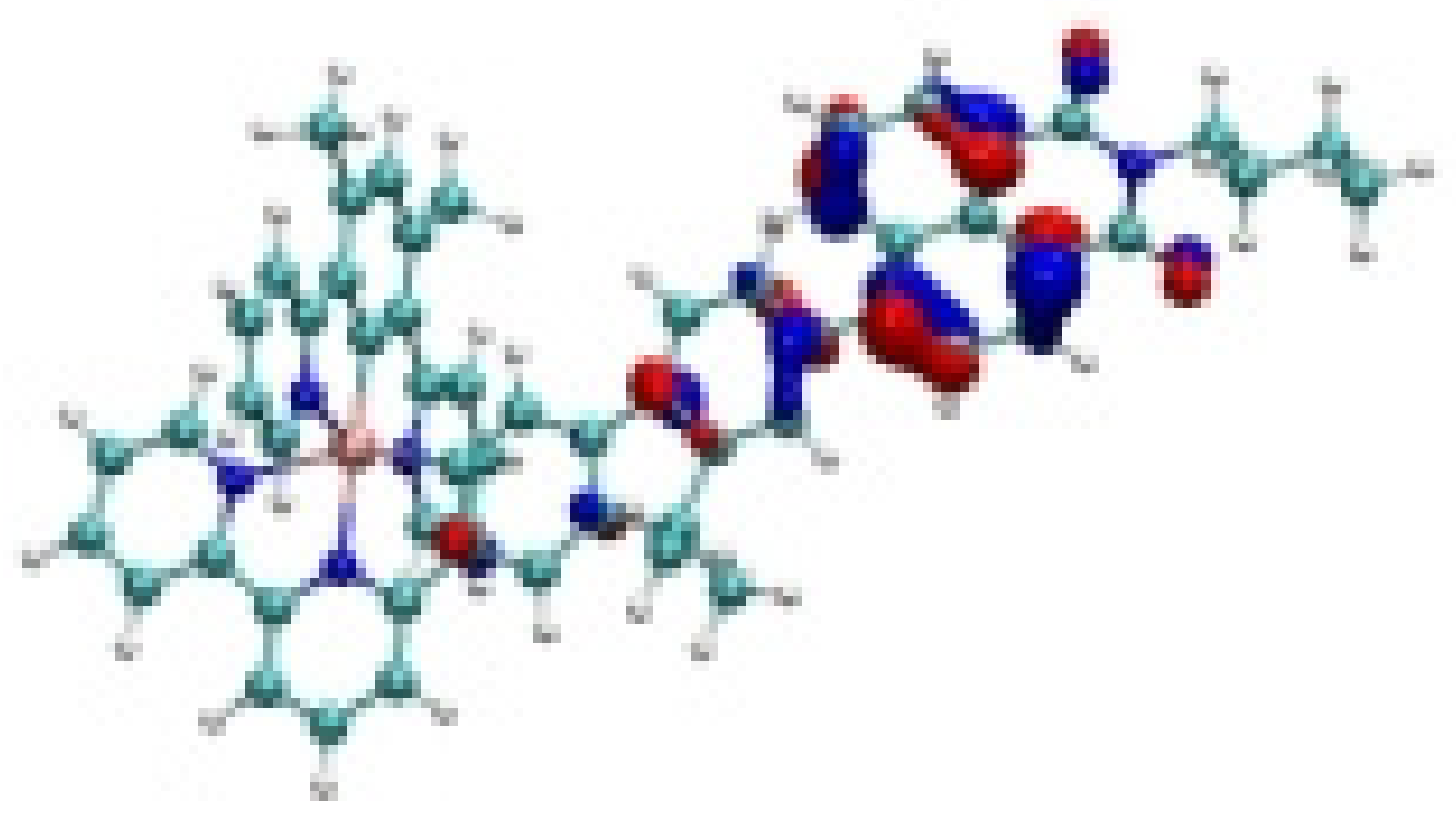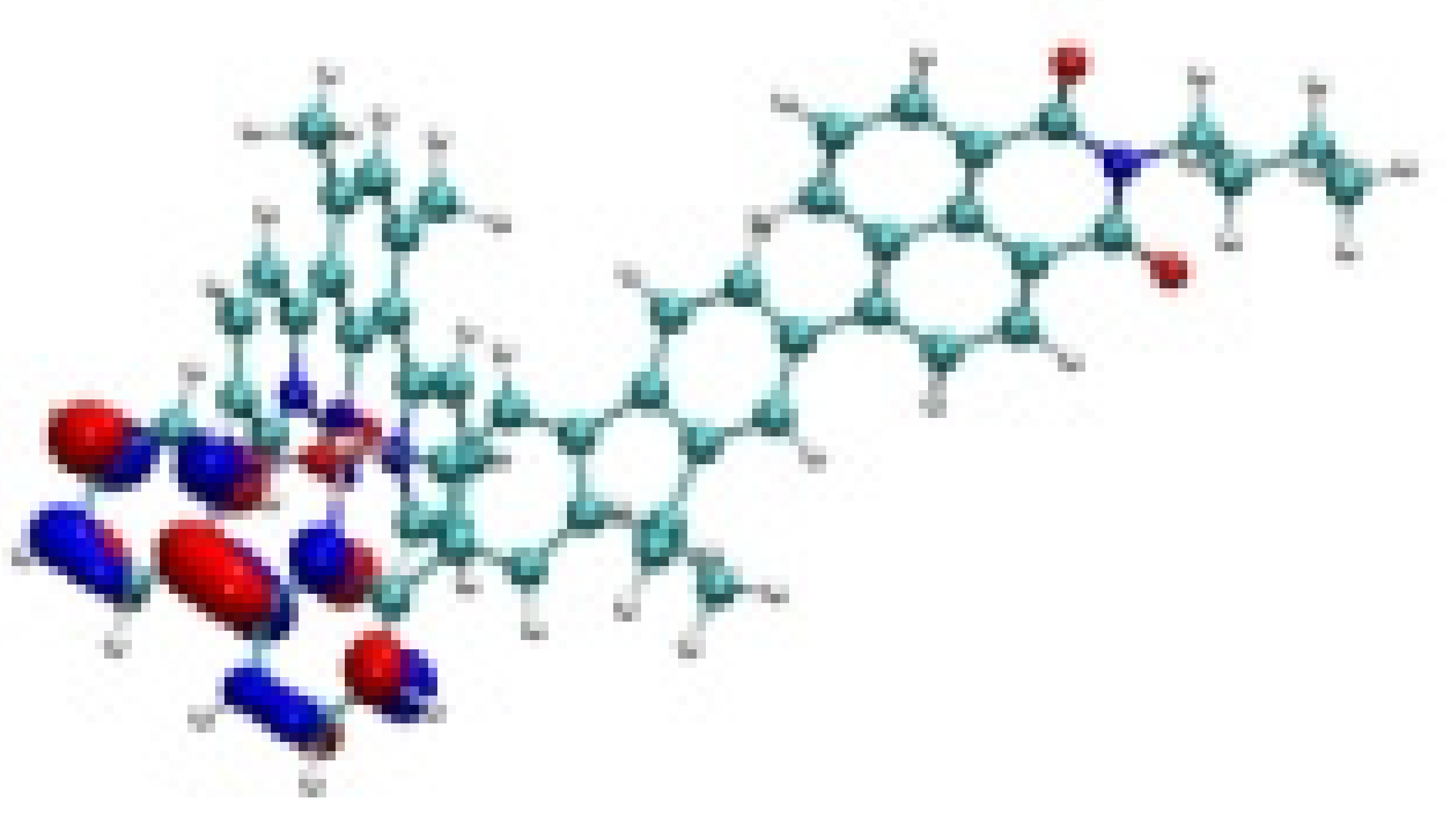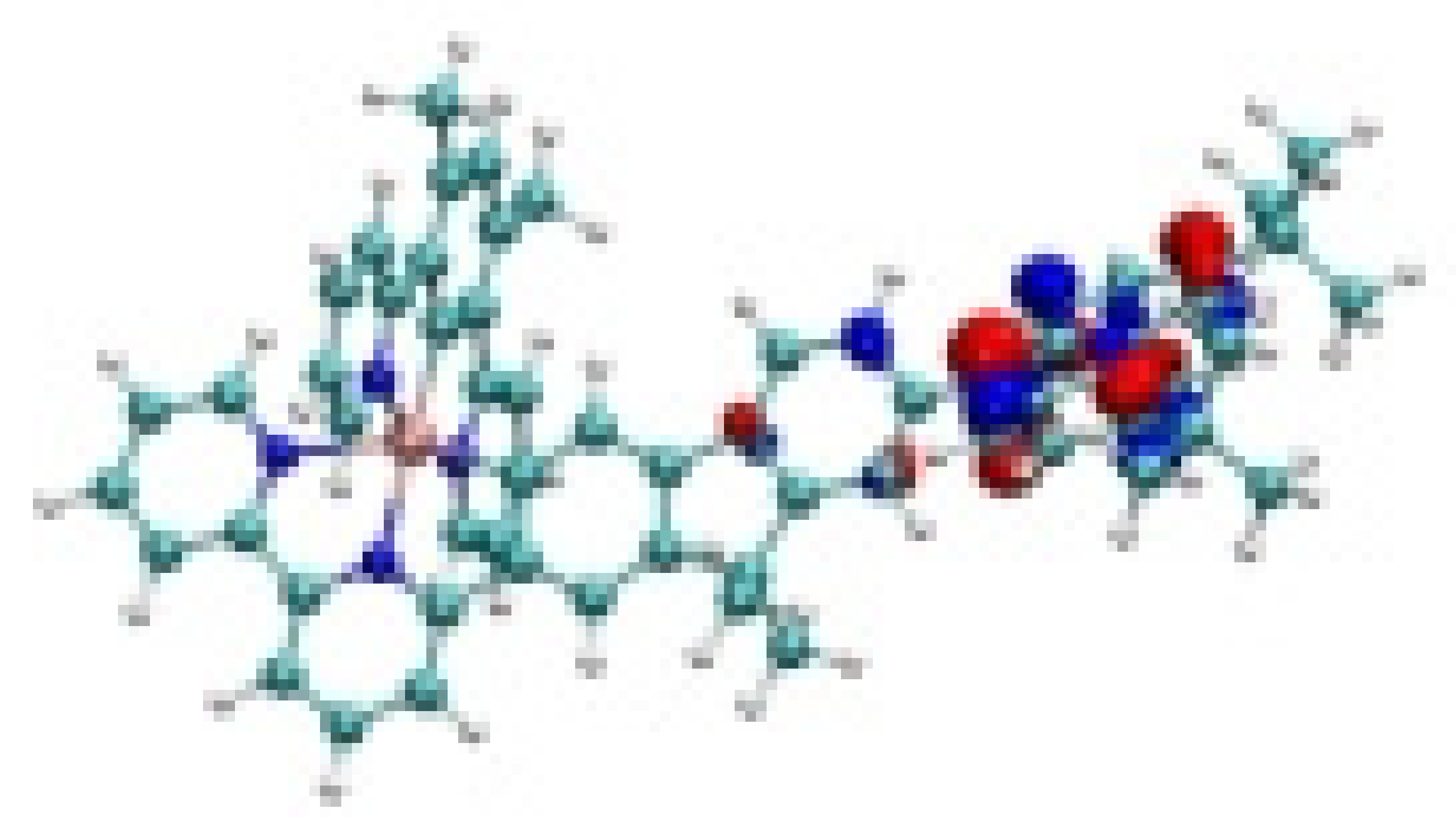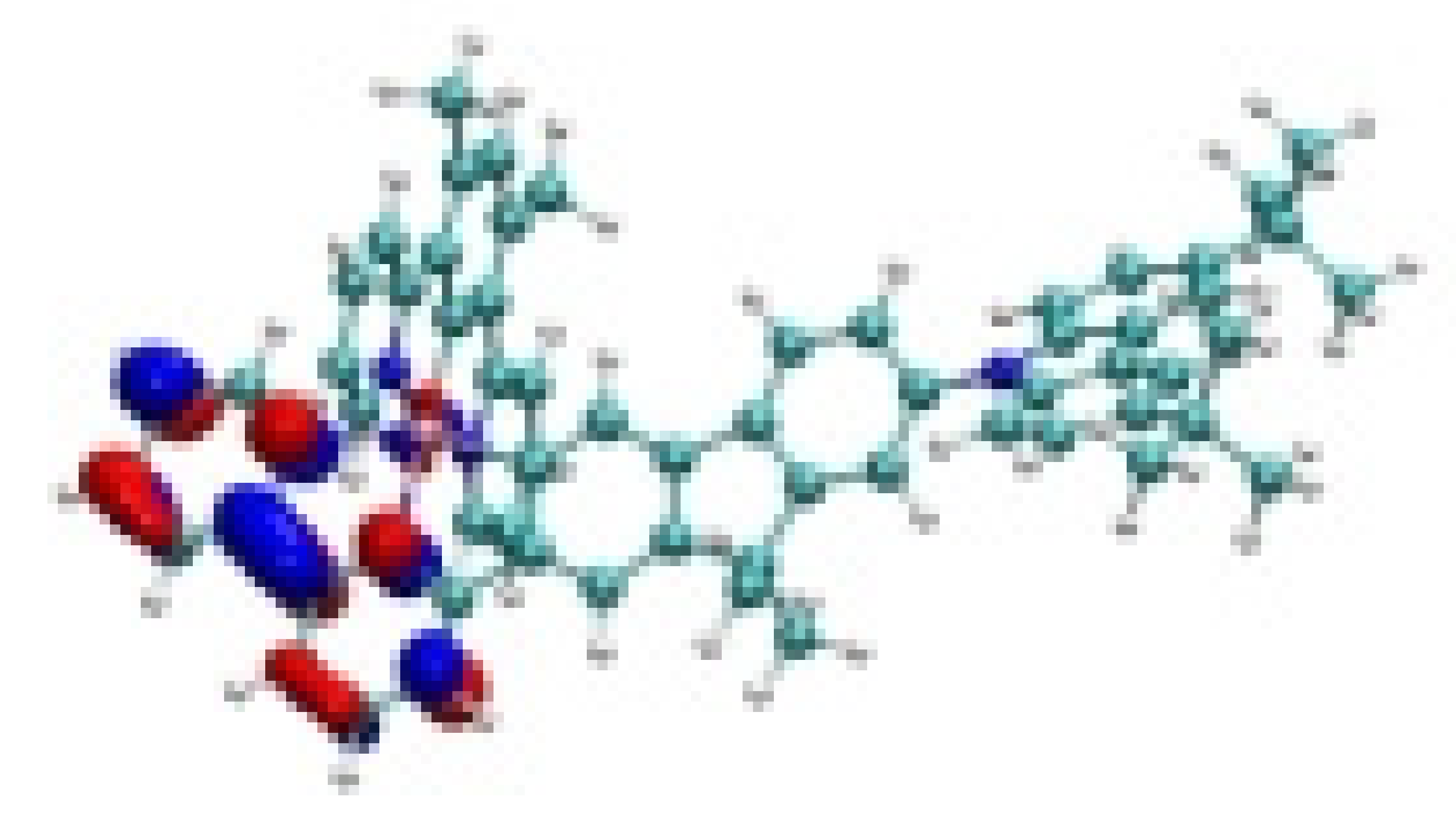Abstract
Five novel bis-tridentate Ir(III) complexes (Ir-1–Ir-5) incorporating versatile N^N^C ligands and a N^C^N ligand (1,3-di(2-pyridyl)-4,6-dimethylbenzene) were synthesized. With the combination of experimental and theoretical methods, their steady and transient state characteristics were researched scientifically. The UV-visible absorption spectra show that the broadband charge transfer absorbance of those bis-tridentate Ir(III) complexes can reach 550 nm, all of these complexes reveal the long-lasting phosphorescent emission. Because the excited-state absorption is more powerful than the ground-state absorption, a sturdy reverse saturable absorption (RSA) process can ensue in the visible and near-infrared regions when the complexes are exposed to a 532 nm laser. Therefore, the optical power limiting (OPL) effect follows the trend: Ir-5 > Ir-4 ≈ Ir-3 > Ir-2 > Ir-1. Generally speaking, the expansion of π-conjugation and the introduction of electron donating/withdrawing groups on the N^N^C ligand could effectively elevate the OPL effect. Therefore, these octahedral bis-tridentate Ir(III) complexes might be exploited as potential OPL materials.
1. Introduction
Ir(III) complexes are extensively used as organic light-emitting devices (OLEDs) [1,2,3,4], low-power up conversions [5,6], organic light-emitting electrochemical transistors [7], photocatalysts [8,9,10], and nonlinear optics [11,12,13]. This application inherently relies on their comprehensive photochemical and photophysical characteristics. The Ir(III) ion’s robust spin-orbit coupling effect leads to high-efficiency intersystem crossing (ISC) and a significant quantum yield of the triplet state [14]. Additionally, their photophysical characteristics may be tuned by structurally modifying the ligands in order to satisfy the necessities for various functions.
Organometallic Ir(III) complexes are thought to be potential nonlinear optical materials due to their extensive ground-state absorption (GSA) and strong excited-state absorption (ESA). Because the ESA is more powerful than the GSA, the reverse saturable absorption (RSA—the absorptivity of these complexes would heighten as the incoming light intensity increased) process occurs, which is one of the nonlinear absorption (NLA) behaviors [15,16,17,18]. In this respect, it has been reported that numerous Ir(III) complexes can be used as effective RSA materials [19,20]. The charge transfer (CT) driven by the D-π interaction between the metal and the chelating ligand is also of benefit to the NLA response [14]. Traditional Ir(III) complexes involving three bidentate ligands have been extensively researched in the field of optical power limiting (OPL) performance, due to their extreme synthetic versatility and tunable triplet excited properties [20,21]. Although the interest in tris-bidentate Ir(III) complexes is certainly increasing, these complexes suffer from unsatisfactory stability, causing by the poor resistance of bidentate chelate for undergoing metal–ligand dissociation [22]. Therefore, bis-tridentate Ir(III) complexes with robust architecture are thus considered to be promising OPL materials.
Since bis-tridentate Ir(III) complexes were first reported by Williams et al. [23], most of the reported works are focused on the field of OLEDs [24,25]. There is far less investigation of bis-tridentate ligands Ir(III) complexes, though interest in OPL materials is certainly increasing. Sun et al. firstly accounted for a variety of bis-cyclometalated Ir (III) complexes, and systematically investigated their NLA properties [21]. Because of the strong σ-donating ability, 2,6-diphenylpyridine (dppy) and its ramifications were selected as the bis-cyclometalating ligand(C^N^C), which endow these Ir(III) complexes with a pronounced bathochromic shift of the charge transfer (1CT)/1π,π* bands to 400−600 nm. To evaluate the feasibility of those complexes as OPL materials, our group further investigated the impact of expanded π-conjugation and replaced substituents on their RSA characteristics [20]. Realizing that the modification of tridentate chelate would certainly influence the RSA properties, the development of those Ir(III) complexes to obtain satisfactory OPL materials remains challenging.
In this work, organometallic Ir(III) complexes bearing N^N^C ligand and N^C^N ligand (1,3-di(2-pyridyl)-4,6-dimethylbenzene) were devised and synthesized (Chart 1). To avoid the bidentate N^C coordination, a pair of substituents (−CH3) were simultaneously inserted at the 4th and 6th locations of the central benzene ring at the same time. Phenanthroline and fluorene were employed as a building block to expand the π-conjugation of N^N^C ligand (Ir-2 and Ir-3), which is due to their high structural rigidities and good charge transporting abilities. Naphthalimide and carbazole units are introduced to further explore the influence of electron donating/withdrawing groups (Ir-4 and Ir-5). A suite of spectroscopic methods and theoretical models were used to investigate their physicochemical characteristics systematically. These directed Ir(III) complexes have adjustable ground-state and triplet excited-state properties, which satisfied the OPL requirements. This work gains insight into the RSA property–structure relationship among these bis-tridentate Ir(III) complexes and serves as a modified version for certain nonlinear optical absorbers [26,27,28].
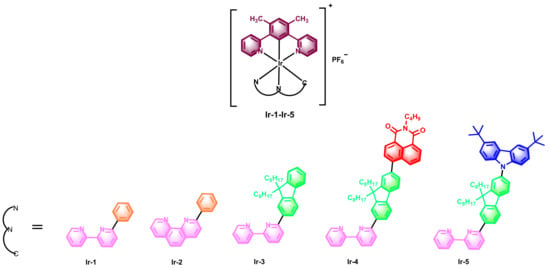
Chart 1.
The molecular structures to complexes Ir-1–Ir-5.
2. Results and Discussion
2.1. Design and Synthesis
To adjust the ground and excited-state characteristics of the bis-tridentate complexes, different strategies were performed. To show the influences of enlarged π-conjugation, additional aromatic rings of the N^N^C ligands were inserted (Ir-2 and Ir-3), while strong electron or withdrawing substituents are recommended to further satisfy the RSA properties for OPL properties. In addition, long alkyl chains were linked to both fluorene and naphthalimide groups, which were used to avoid the intermolecular aggregation and improve the solubility of the Ir(III) complexes.
The N^N^C ligands were created by combining aryl halides with phenylboronic acid in the Suzuki coupling reaction and were obtained in 50–60% yield after recrystallization. A conventional two-step technique was used to accurately produce the corresponding octahedral Ir(III) complexes Ir-1–Ir-5. This two-step method is often disseminated in mild settings, with middling yields. These complexes were all air-stable and soluble in CH2Cl2, toluene, tetrahydrofuran (THF), N, N-dimethylformamide (DMF), and dimethyl sulphoxide (DMSO). The predicted structure of Ir-1–Ir-5 was validated by 1H NMR and HRMS.
2.2. Ground State UV-Vis Absorption
The UV-vis absorption spectra of five Ir(III) complexes in CH3CN are shown in Figure 1, and Table 1 summarized the detailed photophysical data. Below 300 nm, all of these complexes exhibit significant structured absorption bands, which are attributed to the intra-ligand 1π-π* transitions from diimine ligands. The spin-allowed charge transfer transitions, such as 1MLCT (metal-to-ligand changer transfer) and 1LLCT (ligand-to-ligand charger transfer), are responsible for the medium absorption regions at 350–500 nm. For Ir-4 and Ir-5, above 500 nm, the absorption bands of the low energy tail can be referred to a mixed state, including spin-forbidden 3MLCT/3LLCT and 3π-π* transition [29,30]. Comparing the complexes Ir-1, Ir-2, and Ir-3, the increase in π-conjugation on the N^N^C ligand resulted in a red shift in the absorption band. In contrast, the electron-withdrawing/donating substituents evoked a major effect on the energy, and the absorption bands of Ir-4 and Ir-5 are a more bathochromic shift in comparison to those of Ir-3. Additionally, compared with Ir-4, the absorption peak of Ir-5 is further red-shifted, and significantly increases the absorption intensity by a concomitant increase in charge transfer contribution.

Figure 1.
UV-vis absorption spectra of Ir-1–Ir-5 in CH3CN (1 × 10−5 moL/L).

Table 1.
Photophysical data of complexes Ir-1–Ir-5.
2.3. Photoluminescence
To further comprehend the excited-state features, the emission characteristics of these Ir(III) complexes were also investigated. Figure 2 depicts the normalized emission spectra of Ir-1–Ir-5, and the corresponding parameters are reported in Table 1. All of the complexes have congruent room temperature phosphorescence, which is responsive to oxygen, and also have relatively long lifetimes. Their excitation spectra are shown in Figure S1. It is obvious that their excited-state characteristics are influenced by the modified N^N^C ligands. Although these complexes own the wide and structureless emission bands, their emission lifetimes are different. For Ir-1–Ir-3, the expansion of π-conjugation has little influence (111 ns for Ir-1, 105 ns for Ir-2, and 135 ns for Ir-1). However, comparing Ir-3–Ir-5, the introduction of electron-withdrawing/donating substituents prolong their lifetimes (241 ns for Ir-4 and 341 ns for Ir-5), which is due to the intramolecular charge transfer. The emission properties of solvents with different polarities are further studied (Figure 2b–f). Taking Ir-1 for example (Figure 2b), it was discovered that the low energy emission bathochromically moved to longer wavelengths in solvents with higher polarity (e.g., CH3CN) relative to its location in the less polar solvents (e.g., THF). Considering their wide and structureless emission bands and solvatochromic effect (As show in Table 2), the emission properties of these complexes can be mainly ascribed to 3MLCT/3LLCT states with little 3π-π* state [31,32,33].
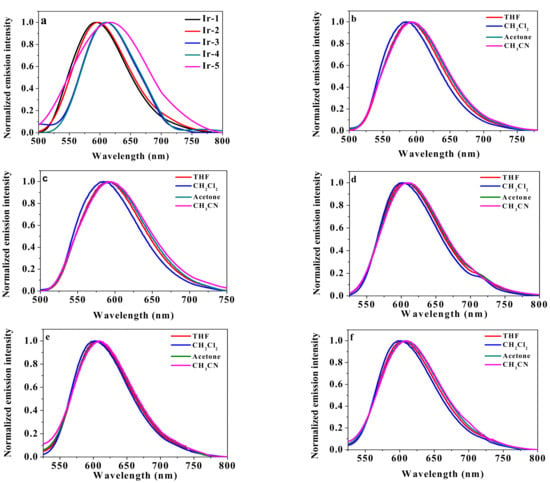
Figure 2.
(a) Normalized emission spectra of complexes Ir-1–Ir-5 in CH3CN (c = 1 × 10−5 mol/L). (b–f) Normalized emission spectra of complexes Ir-1–Ir-5 in different solvents.

Table 2.
Emission wavelength and quantum yields of Ir-1–Ir-5 in different solvents.
2.4. DFT Calculations
To gain a better understanding of the structure–property relationships of these complexes, the DFT calculation was carried out to acquire a thorough grasp of the underlying foundation of the aforementioned experimental findings [34,35]. Table 3 and Table 4 list the excitation energies, wavelengths, oscillator strengths, associated configuration coefficients, and the major principal configuration of the lowest electronic states (highest occupied molecular orbitals (HOMOs) and lowest unoccupied molecular orbitals (LUMOs)). From Table 3, the optical transitions of S1 and T1 states of complexes Ir-1–Ir-5 are primarily from HOMO-1→LUMO and HOMO→LUMO transitions. As shown in Table 4 and Table S1, the electron density of the HOMO of the complexes Ir-1 and Ir-2 is mainly distributed on N^C^N and the center Ir atom, and the LUMO is almost exclusively located in N^N^C ligand (2,2′-bipyridine of Ir-1 and 1,10-phenanthroline of Ir-2). However, the electron density of the HOMO of the complex Ir-3 is mainly distributed on the N^N^C ligand fluorene and Ir atom, while the LUMO is distributed the N^N^C ligands and the central Ir atom. In addition, the LUMO distributions of Ir-4 and Ir-5 share similar properties, while the electron density of the HOMO of the complexes is mainly distributed on the N^N^C ligand, including fluorene and terminal group (naphthalimide on Ir-4 and carbazole on Ir-5). Although the orbital configurations are complicated, the major transitions of all target complexes are associated with the MLCT and LLCT transitions. Moreover, the trends of the calculated S0→S1 transition wavelengths and T1→S0 transition wavelengths for these complexes are similar to the commencement of UV-Vis absorption onset and photoluminescence.

Table 3.
The calculated excitation energies (eV), wavelengths (nm), oscillator strengths, dominant contributing configurations of complexes Ir-1–Ir-5.

Table 4.
Frontier molecular orbitals (HOMO-1, HOMO, and LUMO) in the lowest optical transitions for complexes Ir-1–Ir-5.
2.5. Transient Absorption
Nanosecond transient (TA) absorption of Ir-1–Ir-5 were researched to further comprehend their triplet excited-state properties in order to determine the spectral region where RSA may happen. The nanosecond time-resolved TA spectra for complexes Ir-1–Ir-5 are presented in Figure 3. Table 1 lists the lifetimes of the triplet excited states inferred from the TA decay profile and quantum yields.
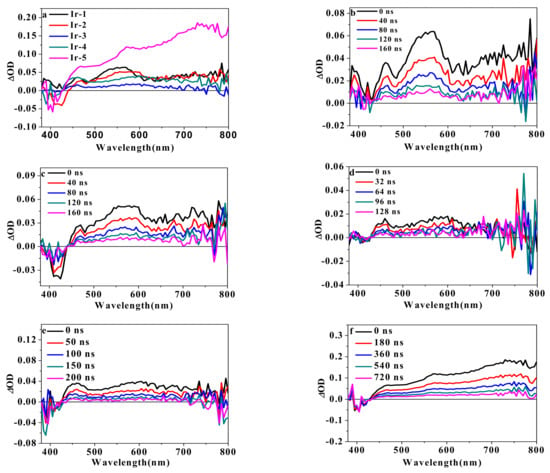
Figure 3.
(a) Nanosecond transient difference absorption spectra of Ir-1–Ir-5 in CH3CN at zero-time decay; (b–f) time-resolved TA spectra of Ir-1–Ir-5. The spectra were all measured in CH3CN, (λex = 355 nm, A355 = 0.4 in a 1 cm cuvette).
These complexes exhibit broad and strong positive absorption bands ranging from ~440 to 800 nm, as seen in Figure 3, which means that the RSA could occur in these ranges. It is noted that the TA spectra of Ir-1 and Ir-2 show the sharp and intense TA bands at ca. 550 nm with short lifetimes, which is due to 3π−π* state from diimine ligands. The lifetimes of the triplet excited states determined by the decay of the transient absorption spectra are 69~86 ns, which are congruous with their emission lifetimes. These characters indicate that the origins of the triplet excited absorption states are the same as those of the emission states. Although the complex Ir-3 shares a similar lifetime, the sharp and intense TA bands disappear because of the increase in charge transfer contribution. On the other hand, the connected electron-donating/withdrawing groups associated with the N^N^C ligands have a significant impact on the intensity and maximum absorption peak of TA for these Ir(III) complexes. Considering that the electron density of the HOMO of the complexes is mainly distributed on the fluorene and terminal groups, it can be conjectured that the observed TA signals from complexes Ir-4 and Ir-5 are thought to be mostly caused by the 3MLCT/3LLCT T1 states. Additionally, the introduction of terminal groups efficaciously prolongs the triplet excited lifetimes (179 ns at 530 nm for Ir-4 and 341 ns at 530 nm for Ir-5). It should be pointed out that the complex Ir-5 presents the longest triplet excited lifetimes and strongest TA signals intensity, especially after 600 nm. As demonstrated in Figure 3f, the broad TA band of Ir-5 kept increasing in the NIR regions, which expands the working window of RSA.
2.6. Optical Power Limiting Properties
All complexes show stronger ESA than the GSA, and the broad positive TA absorption bands (Figure 3) reveal that the RSA process would occur in these ranges. In order to assess the OPL response, the target Ir(III) complexes were irradiated with a 532 nm Nd:YAG laser [13,15,36,37]. For comparison purposes, the concentration in solution was set to 80% transmittance at 532 nm for all samples. Figure 4 demonstrated that all complexes exhibit better OPL performance than the standard OPL material (C60). The output energy density reduced dramatically as the incoming laser’s energy increased. As shown in Figure 4 and Table 5, the intensity of the OPL response corresponds to the trend Ir-5 > Ir-4 ≈ Ir-3 > Ir-2 > Ir-1. The complex Ir-5 exhibited the best OPL ability; when the energy density of the input was raised to 1.5 cm−2, the transmittance is only 20%. Ir-5 has potential to be the broadband reverse saturable absorber in the visible–near-infrared spectral range. Compared with other bis-tridentate Ir(III) complexes, modifying electron-donating units or extending π-conjugation of the ligands is a systematic way to improve the RSA effect [20,21,38].
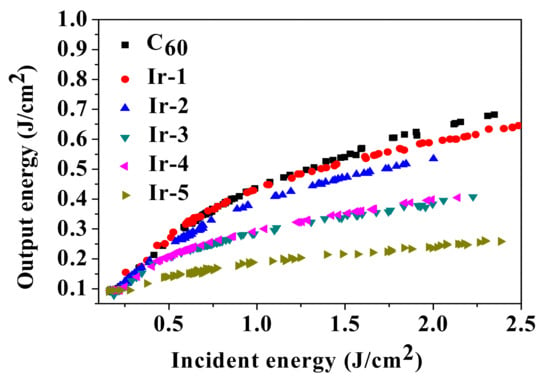
Figure 4.
Output fluence vs. incident fluence for complexes Ir-1–Ir-5 in CH3CN, and C60 in toluene at 532 nm using a 4.1 ns laser pulse.

Table 5.
The F50 of Ir complexes.
Based on the analysis and discussion above, Scheme 1 summarizes the RSA processes involved in the Ir(III) complexes. Under 532 nm laser excitation, the Ir(III) complexes, Ir-1–Ir-5, were excited to the S1 state by 520 nm laser radiation. Then, Ir(III) complexes were stimulated to a higher singlet state (Sn) or under heavy-atom-effect-induced ISC to the first triplet state (T1). The Ir(III) complexes on the T1 state could further absorb the photons to a higher triplet state (Tn) under the laser radiation. When the ESA is stronger than GSA, there is an effective NLA response based on the RSA process.
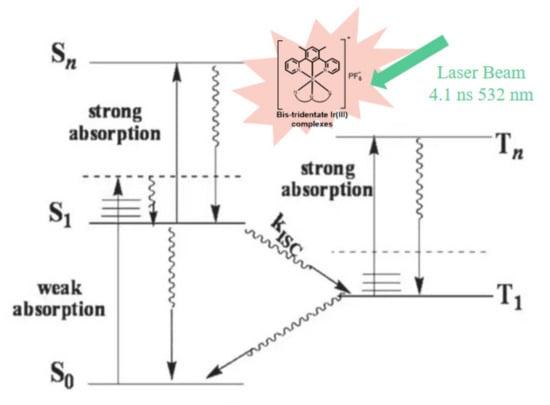
Scheme 1.
Jablonski diagram of the RSA processes of Ir(III) complexes.
3. Experimental Section
3.1. Computational Methods
The ground electronic state frontier molecular orbitals (FMOs) of complexes Ir-1–Ir-5 were simulated by density functional theory (DFT), and their excited electronic states were calculated using the time-dependent density function theory (TDDFT) method. All calculations were performed using the Gaussian 09 software package. The specific DFT method used was PBE1PBE for calculating excited electronic states. The basic sets used in all calculations were the 6–31G* set for all light atoms and the LANL2DZ set for Ir(III) atoms. Full equilibrium geometry optimization was performed for the ground electronic states of all complexes. For consistency with experiments, acetonitrile (CH3CN) used for experimental measurements was selected as the solvent in theoretical calculations as well.
The materials and measurements are described in depth in the supporting information. Scheme 2 outlines the synthesis of the Ir(III) complexes. L0 was synthesized according to methods in the literature [20]. Ligands L1–L5 are also presented in Scheme S1.
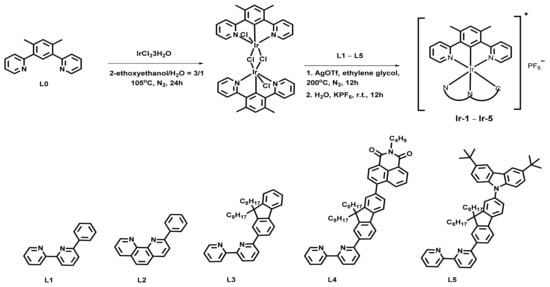
Scheme 2.
The synthetic route to complexes Ir-1–Ir-5.
3.2. Preparation of Complexes
Preparation of the Ir chloride complexes. IrCl3 (200 mg, 0.6 mmol), L0 (0.6 mmol), ethylene glycol (30 mL), and water (10 mL) were added to a 100 mL round-bottom flask under nitrogen. The mixture was refluxed (120 °C) and stirred for 24 h. Then, using water (30 mL) to quench the reaction, the suspension was filtered. The crude product was dried at 45 °C under vacuum. Yellow solid was obtained (183 mg, yield 45%). Without further confirmation, Ir(III) chloride complexes were used in the next reaction.
Preparation of the complexes Ir-1–Ir-5. The µ-chloro-bridged dimer intermediate (523 mg, 0.5 mmol), L1–L5 (1 mmol), ethylene glycol (30 mL), and AgCF3SO3 (617 mg, 2.4 mmol) were added to a 100 mL round-bottom flask under nitrogen. The mixture was refluxed with stirring for 24 h. Then, after cooling to room temperature, excess KPF6 was added and stirred at room temperature for 3 h. The residue was taken into H2O and extracted with dichloromethane three times. The remnant was dried over anhydrous Na2SO4 and concentrated. The mixture was purified by flash chromatography on a silica gel using dichloromethane and methanol (100:1, v/v) as the eluent.
Complex Ir-1. Yellow solid (203 mg, yield 33%). 1H NMR (400 MHz, DMSO-d6) δ 8.86–8.75 (m, 2H), 8.59 (d, J = 8.1 Hz, 1H), 8.39 (t, J = 8.1 Hz, 1H), 8.23 (d, J = 8.4 Hz, 2H), 8.10 (td, J = 8.0, 1.4 Hz, 1H), 7.91 (d, J = 7.3 Hz, 1H), 7.88–7.79 (m, 2H), 7.49 (dd, J = 10.1, 5.0 Hz, 3H), 7.40–7.33 (m, 1H), 7.18 (s, 1H), 6.98 (t, J = 6.5 Hz, 2H), 6.83 (t, J = 7.1 Hz, 1H), 6.62 (t, J = 7.4 Hz, 1H), 5.78 (d, J = 7.1 Hz, 1H), 2.92 (s, 6H). HRMS (ESI) m/z calcd for C34H26IrN4+ (M)+ 683.1781, found 683.1785.
Complex Ir-2. Yellow solid (203 mg, yield 32%). 1H NMR (400 MHz, DMSO-d6) δ 8.90 (q, J = 8.8 Hz, 2H), 8.66 (dd, J = 8.3, 1.2 Hz, 1H), 8.44 (d, J = 8.9 Hz, 1H), 8.23 (d, J = 8.9 Hz, 3H), 8.04 (t, J = 7.5 Hz, 1H), 7.85 (dd, J = 5.0, 1.2 Hz, 1H), 7.82–7.75 (m, 2H), 7.61 (dd, J = 8.2, 5.0 Hz, 1H), 7.40–7.33 (m, 2H), 7.20 (s, 1H), 6.92–6.86 (m, 1H), 6.86–6.78 (m, 2H), 6.65 (td, J = 7.4, 1.3 Hz, 1H), 5.92–5.84 (m, 1H), 2.93 (s, 6H). HRMS (ESI) m/z calcd for C36H26IrN4+ (M)+ 707.1781, found 707.1787.
Complex Ir-3. Yellow solid (203 mg, yield 32%). 1H NMR (400 MHz, DMSO-d6) δ 8.75 (ddd, J = 11.1, 10.4, 5.5 Hz, 3H), 8.38 (dd, J = 9.5, 6.6 Hz, 1H), 8.23 (t, J = 9.8 Hz, 2H), 8.16 (t, J = 7.1 Hz, 1H), 8.08 (t, J = 7.6 Hz, 1H), 7.85–7.72 (m, 2H), 7.46 (dt, J = 10.7, 5.0 Hz, 3H), 7.38–7.33 (m, 1H), 7.31 (d, J = 6.9 Hz, 1H), 7.24 (s, 1H), 7.15 (d, J = 9.2 Hz, 1H), 7.09 (dd, J = 11.8, 7.2 Hz, 2H), 6.93 (t, J = 5.7 Hz, 2H), 6.11 (t, J = 2.6 Hz, 1H), 2.96 (d, J = 3.0 Hz, 6H), 2.09–1.78 (m, 4H), 0.82–0.11 (m, 30H). HRMS (ESI) m/z calcd for C57H62IrN4+ (M)+ 995.4598, found 995.4597.
Complex Ir-4. Yellow solid (153 mg, yield 30%). 1H NMR (400 MHz, DMSO-d6) δ 8.78 (ddd, J = 10.4, 8.1, 2.7 Hz, 3H), 8.55–8.47 (m, 2H), 8.41 (t, J = 7.9 Hz, 1H), 8.26 (dd, J = 9.7, 6.3 Hz, 3H), 8.14–8.07 (m, 1H), 8.07–8.00 (m, 1H), 7.87–7.77 (m, 2H), 7.71 (t, J = 7.8 Hz, 1H), 7.63 (dd, J = 7.5, 1.5 Hz, 1H), 7.53–7.44 (m, 4H), 7.42–7.35 (m, 1H), 7.29 (s, 2H), 7.25 (s, 1H), 6.99–6.90 (m, 2H), 6.21 (d, J = 3.9 Hz, 1H), 4.05 (t, J = 7.2 Hz, 2H), 2.97 (s, 6H), 2.12–1.88 (m, 4H), 1.69–1.55 (m, 2H), 1.40–1.28 (m, 2H), 0.92 (t, J = 7.3 Hz, 3H), 0.77–0.18 (m, 30H). HRMS (ESI) m/z calcd for C73H75IrN5O2+ (M)+ 1246.5544, found 1246.5535.
Complex Ir-5. Yellow solid (203 mg, yield 32%). 1H NMR (400 MHz, DMSO-d6) δ 8.84–8.72 (m, 3H), 8.58–8.49 (m, 2H), 8.41 (t, J = 7.8 Hz, 1H), 8.27 (dd, J = 13.7, 5.9 Hz, 3H), 8.14–8.03 (m, 2H), 7.83 (dd, J = 17.8, 8.9 Hz, 2H), 7.73 (t, J = 7.8 Hz, 1H), 7.65 (d, J = 7.5 Hz, 1H), 7.57–7.43 (m, 4H), 7.39 (d, J = 5.6 Hz, 1H), 7.31 (s, 1H), 7.26 (s, 1H), 6.96 (dd, J = 12.0, 5.9 Hz, 2H), 6.21 (d, J = 3.1 Hz, 1H), 4.07 (t, J = 7.1 Hz, 2H), 2.98 (s, 6H), 2.51 (s, 18H), 2.10–1.91 (m, 4H), 0.87–0.22 (m, 30H). HRMS (ESI) m/z calcd for C77H85IrN5+ (M)+ 1272.6428, found 1272.6435.
4. Conclusions
Five bis-tridentate Ir(III) complexes with different π-conjugation and terminal groups on the N^N^C ligands have been synthesized. In order to better explore the RSA properties, their photophysical characteristics have been thoroughly studied utilizing spectroscopic methods. All Ir(III) complexes exbibit intra-ligand 1π-π* transitions and 1LLCT/1MLCT transition. The modification on the N^N^C ligands generated a bathochromic shift in the absorption band because of the increase in charge transfer contribution. The emission properties of these complexes are from the triplet excited state and can be mainly attributed to 3MLCT/3LLCT states with little 3π-π* state. In addition, the introduction of terminal groups efficaciously prolongs the triplet excited lifetimes. Broadband triplet TA is observed in these complexes in the visible-NIR region. Considering their significantly broader GSA and higher ESA, all complexes produce a substantial NLA response, which follows the descending order Ir-5 > Ir-4 ≈ Ir-3 > Ir-2 > Ir-1. Therefore, these Ir(III) complexes are promising nonlinear absorber materials for the application of OPL.
Supplementary Materials
The following supporting information can be downloaded at https://www.mdpi.com/article/10.3390/molecules28020566/s1: Scheme S1: The molecular structures and synthetic route to complexes L1-L5; Figure S1: The excitation spectra of complexes Ir-1–Ir-5 in CH3CN; Table S1: Contribution of fragments in Ir complexes; Figure S2: 1H NMR spectra (up) and mass spectrometry (down) of Ir-1; Figure S3: 1H NMR spectra (up) and mass spectrometry (down) of Ir-2; Figure S4: 1H NMR spectra (up) and mass spectrometry (down) of Ir-3; Figure S5: 1H NMR spectra (up) and mass spectrometry (down) of Ir-4; Figure S6: 1H NMR spectra (up) and mass spectrometry (down) of Ir-5.
Author Contributions
Conceptualization, S.Z. and R.L.; complexes production and characteristics provision, G.L., Z.J. and M.T.; formal analysis, G.L. and X.J.; computational analysis, M.T. and H.Z.; writing—review and editing, G.L., M.T., Z.J., H.T., S.Z. and R.L.; contributed reagents, materials, and analysis tools, R.L. and H.Z.; supervision, S.Z., R.L. and H.Z.; funding acquisition, S.Z., R.L. and H.Z. All authors have read and agreed to the published version of the manuscript.
Funding
The authors greatly acknowledge the Natural Science Foundation of Jiangsu Province (No. BK20220351), and the Natural Science Foundation of the Jiangsu Higher Education Institutions of China (No. 22KJB150027) for financial support.
Institutional Review Board Statement
Not applicable.
Informed Consent Statement
Not applicable.
Data Availability Statement
Not applicable.
Conflicts of Interest
The authors declare no conflict of interest.
Sample Availability
Samples of the compounds Ir-1–Ir-5 are available from the authors.
References
- Tsuboyama, A.; Iwawaki, H.; Furugori, M.; Mukaide, T.; Kamatani, J.; Igawa, S.; Moriyama, T.; Miura, S.; Takiguchi, T.; Okada, S.; et al. Homoleptic Cyclometalated Iridium Complexes with Highly Efficient Red Phosphorescence and Application to Organic Light-Emitting Diode. J. Am. Chem. Soc. 2003, 125, 12971–12979. [Google Scholar] [CrossRef] [PubMed]
- Parker, S.T.; Slinker, J.D.; Lowry, M.S.; Cox, M.P.; Bernhard, S.; Malliaras, G.G. Improved Turn-on Times of Iridium Electroluminescent Devices by Use of Ionic Liquids. Chem. Mater. 2005, 17, 3187–3190. [Google Scholar] [CrossRef]
- Du, B.-S.; Lin, C.-H.; Chi, Y.; Hung, J.-Y.; Chung, M.-W.; Lin, T.-Y.; Lee, G.-H.; Wong, K.-T.; Chou, P.-T.; Hung, W.-Y.; et al. Diphenyl(1-Naphthyl)Phosphine Ancillary for Assembling of Red and Orange-Emitting Ir(III) Based Phosphors; Strategic Synthesis, Photophysics, and Organic Light-Emitting Diode Fabrication. Inorg. Chem. 2010, 49, 8713–8723. [Google Scholar] [CrossRef] [PubMed]
- Wong, W.-Y.; Zhou, G.-J.; Yu, X.-M.; Kwok, H.-S.; Lin, Z. Efficient Organic Light-Emitting Diodes Based on Sublimable Charged Iridium Phosphorescent Emitters. Adv. Funct. Mater. 2007, 17, 315–323. [Google Scholar] [CrossRef]
- Zhao, W.; Castellano, F.N. Upconverted Emission from Pyrene and Di- Tert -Butylpyrene Using Ir(Ppy) 3 as Triplet Sensitizer. J. Phys. Chem. A 2006, 110, 11440–11445. [Google Scholar] [CrossRef]
- Rachford, A.A.; Ziessel, R.; Bura, T.; Retailleau, P.; Castellano, F.N. Boron Dipyrromethene (Bodipy) Phosphorescence Revealed in [Ir(Ppy) 2 (Bpy-C≡C-Bodipy)] +. Inorg. Chem. 2010, 49, 3730–3736. [Google Scholar] [CrossRef]
- Zhou, Y.; Han, S.; Zhou, G.; Wong, W.-Y.; Roy, V.A.L. Ambipolar Organic Light-Emitting Electrochemical Transistor Based on a Heteroleptic Charged Iridium(III) Complex. Appl. Phys. Lett. 2013, 102, 083301. [Google Scholar] [CrossRef]
- Belmore, K.A.; Vanderpool, R.A.; Tsai, J. Cherng.; Khan, M.A.; Nicholas, K.M. Transition-Metal-Mediated Photochemical Disproportionation of Carbon Dioxide. J. Am. Chem. Soc. 1988, 110, 2004–2005. [Google Scholar] [CrossRef]
- Matt, B.; Moussa, J.; Chamoreau, L.-M.; Afonso, C.; Proust, A.; Amouri, H.; Izzet, G. Elegant Approach to the Synthesis of a Unique Heteroleptic Cyclometalated Iridium(III)-Polyoxometalate Conjugate. Organometallics 2012, 31, 35–38. [Google Scholar] [CrossRef]
- Zhou, X.; Yang, J.; Li, C. Theoretical Study of Structure, Stability, and the Hydrolysis Reactions of Small Iridium Oxide Nanoclusters. J. Phys. Chem. A 2012, 116, 9985–9995. [Google Scholar] [CrossRef]
- Liu, R.; Dandu, N.; Chen, J.; Li, Y.; Li, Z.; Liu, S.; Wang, C.; Kilina, S.; Kohler, B.; Sun, W. Influence of Different Diimine (N ∧ N) Ligands on the Photophysics and Reverse Saturable Absorption of Heteroleptic Cationic Iridium(III) Complexes Bearing Cyclometalating 2-{3-[7-(Benzothiazol-2-Yl)Fluoren-2-Yl]Phenyl}pyridine (C ∧ N) Ligands. J. Phys. Chem. C 2014, 118, 23233–23246. [Google Scholar] [CrossRef]
- Yao, C.; Tian, Z.; Jin, D.; Zhao, F.; Sun, Y.; Yang, X.; Zhou, G.; Wong, W.-Y. Platinum( ii ) Acetylide Complexes with Star- and V-Shaped Configurations Possessing Good Trade-off between Optical Transparency and Optical Power Limiting Performance. J. Mater. Chem. C 2017, 5, 11672–11682. [Google Scholar] [CrossRef]
- Liu, R.; Zhu, S.; Lu, J.; Shi, H.; Zhu, H. Pt(II) Diimine Complexes Bearing Difluoro-Boron-Dipyrromethene Acetylide Ligands: Synthesis, Photophysics, Aggregation Included Emission and Optical Power Limiting Properties. Dyes Pigments 2017, 147, 291–299. [Google Scholar] [CrossRef]
- You, Y.; Nam, W. Photofunctional Triplet Excited States of Cyclometalated Ir(Iii) Complexes: Beyond Electroluminescence. Chem. Soc. Rev. 2012, 41, 7061. [Google Scholar] [CrossRef]
- Li, Y.; Dandu, N.; Liu, R.; Hu, L.; Kilina, S.; Sun, W. Nonlinear Absorbing Cationic Iridium(III) Complexes Bearing Benzothiazolylfluorene Motif on the Bipyridine (N∧N) Ligand: Synthesis, Photophysics and Reverse Saturable Absorption. ACS Appl. Mater. Interfaces 2013, 5, 6556–6570. [Google Scholar] [CrossRef]
- Hirata, S.; Totani, K.; Yamashita, T.; Adachi, C.; Vacha, M. Large Reverse Saturable Absorption under Weak Continuous Incoherent Light. Nat. Mater. 2014, 13, 938–946. [Google Scholar] [CrossRef]
- Dini, D.; Calvete, M.J.F.; Hanack, M. Nonlinear Optical Materials for the Smart Filtering of Optical Radiation. Chem. Rev. 2016, 116, 13043–13233. [Google Scholar] [CrossRef]
- Yuan, G.-J.; Shao, D.-S.; Hu, B.-W.; Liu, W.-L.; Ren, X.-M. A Rotorlike Supramolecular Assembly, {[K(18-Crown-6)]PbI 3 } ∞, with a Reversible Breaking-Symmetry Phase Transition near Room Temperature. Inorg. Chem. 2020, 59, 980–983. [Google Scholar] [CrossRef]
- Tang, M.; Zhu, S.; Liu, R.; Wang, J.; Zhang, Z.; Zhu, H. Synthesis, Characterization and Optical Properties of Novel Ir(III) Complexes Bearing N-Heterocycle Substituents. J. Organomet. Chem. 2019, 880, 363–367. [Google Scholar] [CrossRef]
- Lu, J.; Pan, Q.; Zhu, S.; Liu, R.; Zhu, H. Ligand-Mediated Photophysics Adjustability in Bis-Tridentate Ir(III) Complexes and Their Application in Efficient Optical Limiting Materials. Inorg. Chem. 2021, 60, 12835–12846. [Google Scholar] [CrossRef]
- Liu, B.; Jabed, M.A.; Kilina, S.; Sun, W. Synthesis, Photophysics, and Reverse Saturable Absorption of Trans -Bis-Cyclometalated Iridium (III) Complexes (C^N^C)Ir(R-Tpy) + (Tpy = 2,2′:6′,2″-Terpyridine) with Broadband Excited-State Absorption. Inorg. Chem. 2020, 59, 8532–8542. [Google Scholar] [CrossRef] [PubMed]
- Kuei, C.-Y.; Liu, S.-H.; Chou, P.-T.; Lee, G.-H.; Chi, Y. Room Temperature Blue Phosphorescence: A Combined Experimental and Theoretical Study on the Bis-Tridentate Ir( iii ) Metal Complexes. Dalton Trans. 2016, 45, 15364–15373. [Google Scholar] [CrossRef] [PubMed]
- Whittle, V.L.; Williams, J.A.G. A New Class of Iridium Complexes Suitable for Stepwise Incorporation into Linear Assemblies: Synthesis, Electrochemistry, and Luminescence. Inorg. Chem. 2008, 47, 6596–6607. [Google Scholar] [CrossRef] [PubMed]
- Kuei, C.-Y.; Tsai, W.-L.; Tong, B.; Jiao, M.; Lee, W.-K.; Chi, Y.; Wu, C.-C.; Liu, S.-H.; Lee, G.-H.; Chou, P.-T. Bis-Tridentate Ir(III) Complexes with Nearly Unitary RGB Phosphorescence and Organic Light-Emitting Diodes with External Quantum Efficiency Exceeding 31%. Adv. Mater. 2016, 28, 2795–2800. [Google Scholar] [CrossRef] [PubMed]
- Gildea, L.F.; Batsanov, A.S.; Williams, J.A.G. Bright Orange/Red-Emitting Rhodium (Iii) and Iridium(Iii) Complexes: Tridentate N^C^N-Cyclometallating Ligands Lead to High Luminescence Efficiencies. Dalton Trans. 2013, 42, 10388. [Google Scholar] [CrossRef]
- Guo, F.; Sun, W.; Liu, Y.; Schanze, K. Synthesis, Photophysics, and Optical Limiting of Platinum (II) 4‘-Tolylterpyridyl Arylacetylide Complexes. Inorg. Chem. 2005, 44, 4055–4065. [Google Scholar] [CrossRef]
- Shao, P.; Li, Y.; Sun, W. Cyclometalated Platinum (II) Complex with Strong and Broadband Nonlinear Optical Response. J. Phys. Chem. A 2008, 112, 1172–1179. [Google Scholar] [CrossRef]
- Yi, J.; Zhang, B.; Shao, P.; Li, Y.; Sun, W. Synthesis and Photophysics of Platinum (II) 6-Phenyl-4-(9,9-Dihexylfluoren-2-Yl)-2,2′-Bipyridine Complexes with Phenothiazinyl Acetylide Ligand. J. Phys. Chem. A 2010, 114, 7055–7062. [Google Scholar] [CrossRef]
- Wu, S.-H.; Ling, J.-W.; Lai, S.-H.; Huang, M.-J.; Cheng, C.H.; Chen, I.-C. Dynamics of the Excited States of [Ir(Ppy) 2 Bpy] + with Triple Phosphorescence. J. Phys. Chem. A 2010, 114, 10339–10344. [Google Scholar] [CrossRef]
- Zhao, Q.; Liu, S.; Shi, M.; Wang, C.; Yu, M.; Li, L.; Li, F.; Yi, T.; Huang, C. Series of New Cationic Iridium(III) Complexes with Tunable Emission Wavelength and Excited State Properties: Structures, Theoretical Calculations, and Photophysical and Electrochemical Properties. Inorg. Chem. 2006, 45, 6152–6160. [Google Scholar] [CrossRef]
- Zhu, Z.-L.; Chen, W.-C.; Ni, S.-F.; Yan, J.; Wang, S.F.; Fu, L.-W.; Tsai, H.-Y.; Chi, Y.; Lee, C.-S. Constructing Deep-Blue Bis-Tridentate Ir( iii ) Phosphors with Fluorene-Based Dianionic Chelates. J. Mater. Chem. C 2021, 9, 1318–1325. [Google Scholar] [CrossRef]
- Tai, W.-S.; Gnanasekaran, P.; Chen, Y.-Y.; Hung, W.-Y.; Zhou, X.; Chou, T.-C.; Lee, G.-H.; Chou, P.-T.; You, C.; Chi, Y. Rational Tuning of Bis-Tridentate Ir(III) Phosphors to Deep-Blue with High Efficiency and Sub-Microsecond Lifetime. ACS Appl. Mater. Interfaces 2021, 13, 15437–15447. [Google Scholar] [CrossRef]
- Zhu, S.; Pan, Q.; Li, Y.; Liu, W.; Liu, R.; Zhu, H. Fluorene-Decorated Ir (III) Complexes: Synthesis, Photophysics and Tunable Triplet Excited State Properties in Aggregation. Dalton Trans. 2022, 51, 13322–13330. [Google Scholar] [CrossRef]
- Liu, J.-Q.; Luo, Z.-D.; Pan, Y.; Kumar Singh, A.; Trivedi, M.; Kumar, A. Recent Developments in Luminescent Coordination Polymers: Designing Strategies, Sensing Application and Theoretical Evidences. Coord. Chem. Rev. 2020, 406, 213145. [Google Scholar] [CrossRef]
- Zhou, S.; Lu, L.; Liu, D.; Wang, J.; Sakiyama, H.; Muddassir, M.; Nezamzadeh-Ejhieh, A.; Liu, J. Series of Highly Stable Cd (ii)-Based MOFs as Sensitive and Selective Sensors for Detection of Nitrofuran Antibiotic. CrystEngComm 2021, 23, 8043–8052. [Google Scholar] [CrossRef]
- Büldt, L.A.; Guo, X.; Vogel, R.; Prescimone, A.; Wenger, O.S. A Tris(Diisocyanide)Chromium(0) Complex Is a Luminescent Analog of Fe(2,2′-Bipyridine)32+. J. Am. Chem. Soc. 2017, 139, 985–992. [Google Scholar] [CrossRef]
- Lu, T.; Wang, C.; Lystrom, L.; Pei, C.; Kilina, S.; Sun, W. Effects of Extending the π-Conjugation of the Acetylide Ligand on the Photophysics and Reverse Saturable Absorption of Pt(ii) Bipyridine Bisacetylide Complexes. Phys. Chem. Chem. Phys. 2016, 18, 28674–28687. [Google Scholar] [CrossRef]
- Hongbing, Z.; Wenzhe, C.; Minquan, W.; Chunlin, Z. Optical Limiting Effects of Multi-Walled Carbon Nanotubes Suspension and Silica Xerogel Composite. Chem. Phys. Lett. 2003, 382, 313–317. [Google Scholar] [CrossRef]
Disclaimer/Publisher’s Note: The statements, opinions and data contained in all publications are solely those of the individual author(s) and contributor(s) and not of MDPI and/or the editor(s). MDPI and/or the editor(s) disclaim responsibility for any injury to people or property resulting from any ideas, methods, instructions or products referred to in the content. |
© 2023 by the authors. Licensee MDPI, Basel, Switzerland. This article is an open access article distributed under the terms and conditions of the Creative Commons Attribution (CC BY) license (https://creativecommons.org/licenses/by/4.0/).
